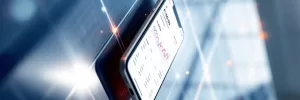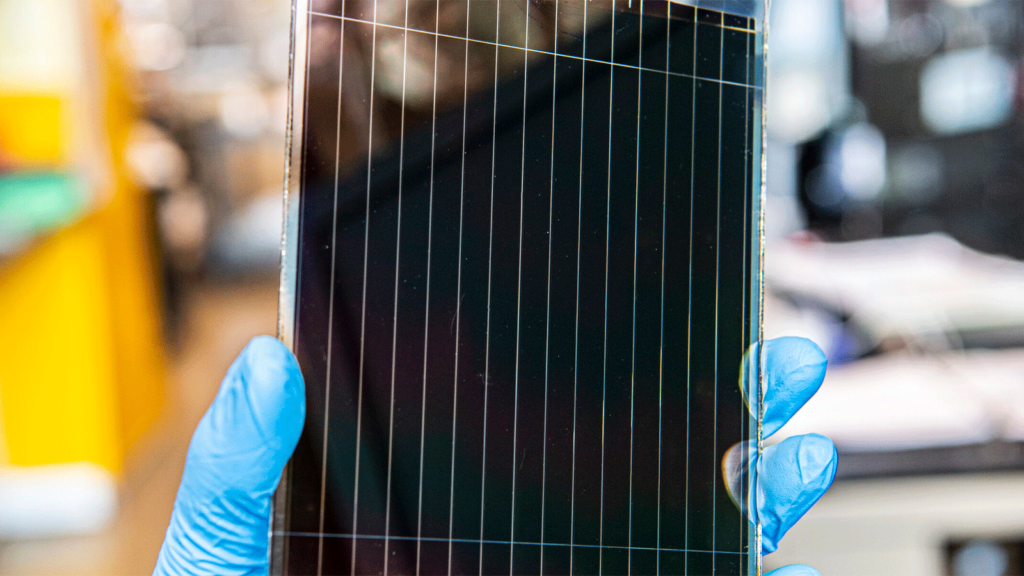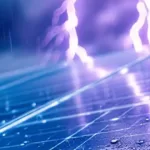Table of Contents
Introduction
With the growing global demand for renewable energy, perovskite solar cells have garnered significant attention as an emerging photovoltaic technology. These third-generation solar cells, based on perovskite-structured materials, exhibit tremendous potential due to their high efficiency, low cost, and diverse application scenarios. This article aims to provide a comprehensive overview of perovskite solar cells, covering their basic concepts, advantages, technical challenges, latest research developments, and potential applications, offering readers a thorough understanding of this promising technology.
What Are Perovskite Solar Cells?
Perovskite solar cells are a type of third-generation solar cell that utilize perovskite-structured materials. Perovskites are a class of materials characterized by a specific crystal structure, typically represented by the chemical formula ABX₃. In this formula, ‘A’ and ‘B’ are two different metal cations, and ‘X’ is an anion, together forming a unique crystal lattice. In the context of perovskite solar cells, ‘A’ and ‘B’ are usually composed of organic molecules and metal halides. This combination results in materials with exceptional light-absorbing and electronic properties, making perovskite solar cells a promising alternative to traditional photovoltaic technologies.

Advantages of Perovskite Solar Cells Compared to Silicon-Based Cells
Perovskite solar cells offer several advantages over traditional silicon-based cells, including PERC, TOPCon, IBC, and HJT cells:
1.High Efficiency: Perovskite solar cells exhibit high efficiency levels. The theoretical maximum conversion efficiency of single-junction perovskite cells can reach up to 31%, while multi-junction perovskite cells can achieve theoretical efficiencies as high as 45%, significantly surpassing the 29.4% efficiency limit of silicon-based cells.
2.Low Cost: Perovskite materials are less sensitive to impurities, allowing cells with over 20% efficiency to be produced using perovskite materials of around 90% purity. In contrast, silicon requires a purity level of 99.9999% for effective use. Additionally, the production of perovskite solar cells requires a relatively lower investment in the industrial supply chain, needing only a single factory compared to the four factories required for silicon-based cells (silicon material, silicon wafer, cell, and module).
3.Wide Range of Applications: Perovskite solar cells can be manufactured in flexible, lightweight forms, making them suitable for various applications, including building-integrated photovoltaics (BIPV), flexible displays, wearable clothing, tents, portable power supplies, and other portable devices.
4.Excellent Performance in Low-Light Conditions: Perovskite materials can operate efficiently in low-light environments, such as cloudy weather or during dawn and dusk. This enables perovskite solar cells to maintain good performance even under suboptimal lighting conditions, enhancing their overall energy generation potential.

Technical Challenges in Practical Applications of Perovskite Cells
Perovskite solar cells, despite their promising features, still face several technical challenges in practical applications:
1.Long-Term Stability: The stability of perovskite materials under environmental factors such as humidity, temperature, and light exposure is a significant challenge. Perovskite solar cells may degrade when exposed to these conditions over extended periods. While laboratory tests have shown lifespans of about one year, this still falls short compared to silicon solar cells. Standardizing stability testing is a current research focus.
2.Balancing Efficiency and Stability: Increasing the conversion efficiency of perovskite solar cells often compromises their long-term stability. High-efficiency perovskite cells sometimes perform poorly in long-term stability tests. Finding the optimal balance between efficiency and stability is a crucial research goal.
3.Efficiency Loss in Large-Area Applications: The uniformity and density of perovskite layers in large-area applications are closely related to efficiency loss. Small-area perovskite cells produced in laboratories may achieve high efficiency, but this efficiency can decrease when scaled up to larger, practical applications.
4.Unsettled Material Systems: The manufacturing of perovskite cells involves various material choices, and the material system is not yet fully standardized. This increases uncertainty and costs in the production process. Different research teams may use different perovskite material combinations, leading to variations in performance and stability outcomes.
5.Uncertainty in Crystallization Processes: The manufacturing process of perovskite cells involves complex crystallization processes, and uncertainties in these processes can affect cell performance and stability. Different crystallization methods and conditions can result in significant variations in the quality and performance of perovskite thin films.
6.Encapsulation and Protection: Effective encapsulation techniques are needed to protect perovskite cells from environmental factors. This includes selecting suitable encapsulation materials and processes to shield the cells from moisture and oxygen.
Latest Research Developments in Perovskite Solar Cells
In 2024, significant advancements have been made in the research of perovskite solar cells. Here are some of the key developments:
1.HUST Wuhan National Laboratory for Optoelectronics: The team led by Wei Chen and Zonghao Liu published a study in Nature demonstrating the use of a self-assembled monolayer hybrid hole transport material (HTM) to enhance the efficiency of inverted perovskite solar cells. This material offers ultra-wettability, nanoscale uniform distribution, fast carrier extraction, and low non-radiative recombination. These properties enable efficient carrier transport and defect passivation at the buried interface, significantly improving device performance. The resulting inverted perovskite solar cells achieved a quasi-steady-state efficiency of 26.54%, certified by an authoritative third-party institution, surpassing the previous record for certified efficiency.
2.Tsinghua University: The team led by Yichen Yi developed a new hole transport material (HTM-T2) combined with vacuum-deposited perovskite thin films, achieving a world record efficiency of 26.41% for perovskite solar cells. HTM-T2 can be synthesized from low-cost commercial raw materials through a few steps, making it highly suitable for mass production. The team also achieved a certified efficiency of 26.21% for PSCs with a 0.1 cm² area and 24.88% for PSCs with a 1.0 cm² aperture area.
3.Institute of Chemistry, Chinese Academy of Sciences: The team led by Yongfang Li and Lei Meng proposed a localized oxidation engineering (LOE) strategy to effectively control and maintain the appropriate oxidation state of SnO2 in the electron transport layer. By adding ammonium dichromate as an oxidizer, they compensated for excess oxygen vacancies and formed an ultra-thin Cr2O3 p-type semiconductor layer as the reduction product. The Cr2O3/SnO2 nanometer p-n junction enhances charge extraction and reduces non-radiative recombination at the buried interface. The α-FAPbI3-based perovskite solar cells with this ETL achieved a PCE of 25.72% (certified efficiency of 25.41%) and demonstrated T90>700h operational stability under continuous 1 sun illumination.
4.Shanghai Jiao Tong University: In March 2024, a research team published a study in Science showing that their inverted perovskite solar cells maintained 98.5% of their initial efficiency after 1000 hours of storage at 85% relative humidity and 85°C. Additionally, these cells retained 98.2% of their initial efficiency after operating at the maximum power point for 1200 hours at 85°C.
These developments highlight the significant progress in enhancing the efficiency, stability, and scalability of perovskite solar cells, bringing them closer to practical and commercial viability.
Potential Applications of Perovskite Solar Cells
Perovskite solar cells have a wide range of potential applications due to their unique advantages, such as high efficiency, lightweight, flexibility, and semi-transparency. Here are some potential use cases:
1.Building-Integrated Photovoltaics (BIPV): Perovskite solar cells can be integrated into building materials such as windows, glass facades, or roofs, combining aesthetics with energy production.
2.Portable Power Sources: Their lightweight and flexible nature allows perovskite solar cells to be integrated into portable electronic devices like smartphones, tablets, and wearables, providing wireless charging capabilities.
3.Vehicle Integration: Perovskite solar cells can be incorporated into the surfaces of vehicles, drones, and electric bicycles, providing additional power, extending driving range, or reducing reliance on external power sources.
4.Off-Grid Power: In remote areas or developing countries, perovskite solar cells can be part of off-grid power systems, supplying clean electricity.
5.Indoor Photovoltaic Applications: Due to their strong light absorption, perovskite solar cells can generate electricity even under indoor lighting conditions, suitable for indoor lighting and low-power devices like sensors.
6.Space Applications: The lightweight and high-efficiency properties of perovskite solar cells make them ideal for space applications, providing power for satellites and other spacecraft.
7.Agriculture: Perovskite solar cells can be used in agricultural monitoring and automation systems, such as irrigation controllers, weather stations, and crop monitoring devices.
8.Military and Defense: Due to their high efficiency and portability, perovskite solar cells can be used in military equipment and unmanned reconnaissance drones, providing reliable power.
9.Consumer Electronics: Perovskite solar cells can be integrated into various consumer electronic products, such as e-readers, portable speakers, and digital watches.
10.Disaster Relief and Emergency Response: In natural disasters or emergencies, perovskite solar cells can be rapidly deployed to provide immediate power for rescue operations.
These diverse application scenarios highlight the versatility and potential of perovskite solar cells, positioning them as a transformative technology in the energy sector.
Conclusion
Research and applications of perovskite solar cells are continuously advancing, presenting boundless potential for future development. With ongoing technological breakthroughs and continuous cost reductions, perovskite solar cells are poised to play a significant role in the future photovoltaic market, contributing to global energy transition and sustainable development. We look forward to the large-scale commercialization of perovskite solar cells in the near future, bringing cleaner and more efficient energy solutions to humanity.
Since 2008, Maysun Solar has been dedicated to producing high-quality photovoltaic modules. Maysun Solar offers a variety of TOPCon, IBC, HJT solar panels, as well as balcony solar power stations. These solar panels boast excellent performance and stylish design, seamlessly integrating with any building. Maysun Solar has successfully established offices and warehouses in many European countries and has long-term partnerships with excellent installers! Please feel free to contact us for the latest module quotes or any photovoltaic inquiries. We are happy to assist you.
Reference:
National Research Council. (2007). Advanced Solar Photon Conversion: Concepts, Technologies, and Applications. The National Academies Press. https://doi.org/10.17226/11976
Green, M. A., Emery, K., Hishikawa, Y., Warta, W., & Dunlop, E. D. (2012). Solar cell efficiency tables (Version 38). Progress in Photovoltaics: Research and Applications, 20(1), 12-15. https://doi.org/10.1002/pip.1074
NREL. (2023). Best Research-Cell Efficiency. National Renewable Energy Laboratory (NREL). https://www.nrel.gov/pv/cell-efficiency.html
Stranks, S. D., & Snaith, H. J. (2013). Organic–inorganic perovskites for photovoltaic applications. Advanced Materials, 25(22), 2966-2981. https://doi.org/10.1002/adma.201204079
National Renewable Energy Laboratory (NREL). (2023). Photovoltaic Research – Perovskite Solar Cells. https://www.nrel.gov/pv/perovskite-solar-cells.html
Oxford PV. (2023). The Technology – Oxford PV. https://www.oxfordpv.com/technology
Green, M. A., & Hoegel, J. (1989). Solar cell efficiency tables. Progress in Photovoltaics: Research and Applications, 7(1), 3-8. https://doi.org/10.1002/pip.4670070103
Green, M. A. (2018). Solar cell efficiency tables (Version 53). Journal of Photovoltaics, 8(1), 3-12. https://doi.org/10.1109/JPHOTOV.2017.2786899
Department of Energy. (2023). Basic Research Needs for Solar Energy Utilization. https://www.energy.gov/eere/articles/basic-research-needs-solar-energy-utilization
National Research Council. (2011). Solar Energy Technologies for the 21st Century: The Role of the National Renewable Energy Laboratory. The National Academies Press. https://doi.org/10.17226/13256
Green, M. A., Emery, K., Hishikawa, Y., Warta, W., & Dunlop, E. D. (2012). Solar cell efficiency tables (Version 39). Progress in Photovoltaics: Research and Applications, 21(1), 8-13. https://doi.org/10.1002/pip.2464

Empowering Factories with Solar Energy A Strategic Tool for Controlling Production Electricity Costs
Commercial and industrial solar is becoming a key solution for factories to reduce electricity costs and hedge against price fluctuations. This article systematically analyzes its deployment models, cost advantages, and sustainable value pathways.

How Businesses Can Offset Carbon Taxes with Solar Power
This article analyzes the latest carbon tax policies and photovoltaic deduction strategies, helping European businesses legally reduce taxes, increase profits through solar investment, and achieve a win-win situation for both economy and environment.

Forecast and Response: Seizing the Next Decade’s Growth Dividend in Europe’s Commercial and Industrial Photovoltaics Market
Maysun Solar analyzes the growth trends of commercial and industrial photovoltaics in Europe over the next ten years, from policies and ESG to technological innovation, helping companies seize the initiative in the energy transition.

How to Calculate Solar System ROI and Optimize Long-Term Returns?
Solar power is becoming a key solution for businesses to reduce costs and improve efficiency. Accurately calculating ROI and optimizing long-term returns are essential to maximizing investment value.

Will Agrivoltaics Affect Crop Growth?
Agrivoltaics combines solar energy and agriculture to reduce up to 700 tons of CO₂ per MW, improve water use, and boost crop growth for sustainable farming.

6.5 Billion Loss Hits Photovoltaics: Reshaping or Elimination?
In 2025, the photovoltaic market may see a turnaround as some companies take early action. A €6.5 billion loss is driving businesses to explore new growth areas like energy storage and hydrogen. Which giants will break through? Industry transformation is accelerating!



